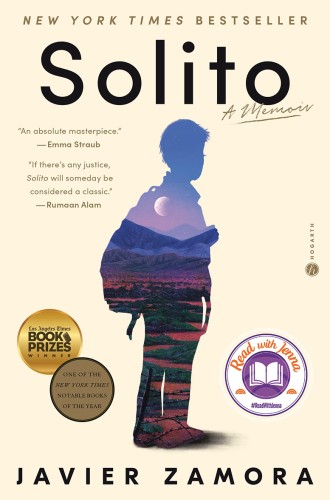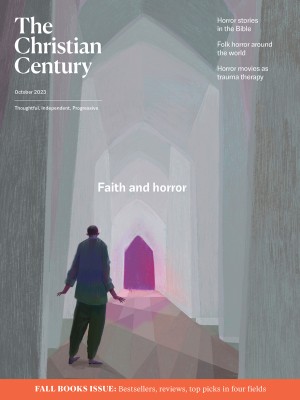Migration through a child’s eyes
Javier Zamora’s memoir chronicles the harrowing solo journey he made from El Salvador to the US at age nine.
In December 2020, in the middle of the COVID pandemic and a month before Joe Biden was inaugurated, I visited the Arizona-Mexico border to learn about the border wall that the Trump administration was building and how it was impacting immigration policy. My guide was Father Neeley, a Jesuit priest who works for a migrant relief organization based in Nogales, a town that spans the border.
The day after I arrived, Father Neeley invited me to a mass he was giving in Arivaca, Arizona, a town 11 miles north of the border that sits on a route frequently used by coyotes bringing migrants across. As we bumped and rocked along the potholed asphalt to the church in my shiny blue rental car, Father Neeley explained why so many coyotes use this route: “Unlike further west, there’s no road to or along the border here, so ICE and the Border Patrol cannot get there, except in ATVs. They have to rely on drones and high-tech surveillance equipment.”
Read our latest issue or browse back issues.
As we neared Arivaca, he had me pull over. “Get out and walk a bit,” he said. “Down in that valley over there. That’s the path that the migrants follow, through those mountains.” I climbed out and stumbled around in the hot, rocky terrain, amid the mesquite trees and scrub brush—and tried to imagine what the migrants endured. “Everything out here sticks or pricks or bites you,” Father Neeley said. “A gallon of water weighs eight and a half pounds. Can you imagine walking 20 or 30 miles through this terrain and heat with several gallons of water, a couple of kids, and nothing to eat?” I could not.
Those words of Father Neeley welled up in me when I read Javier Zamora’s memoir. Somehow, Zamora enables readers to imagine the unimaginable, to begin to understand a migrant’s harrowing journey across the border.
Solito takes place in 1999, long before Trump’s border wall. Zamora recounts his two-month journey as a nine-year-old—by bus, boat, and foot—from his home in a Salvadoran fishing village to meet his parents in Tucson. The parents, having emigrated several years prior due to the war, pay a coyote to bring Javier across.
Javier’s grandfather accompanies him on the first stage of the trip, from San Salvador to the Guatemala-Mexico border. There he is left with Don Dago—the same coyote his mother used—and a group of 30 other migrants. Javier knows no one and is the younger of the two children in the group. During that first week, in a Guatemalan village, he is lonely and afraid:
I stare at the ceiling, waiting for something to fall on my bed—a cockroach in my mouth, a spider on my eye, a scorpion at my feet. There’s no mosquito net hanging on the top of my bed like back home. Grandpa isn’t here to talk to me before falling asleep, to go out for walks and explore the town, and because of that I feel alone, lonely, solo, solito, solito de verdad.
This loneliness and fear evolve throughout the book, as Javier gains courage and confidence from some of his fellow travelers.
In order to get through the various security checks, he and three others in the group are given fake Mexican IDs and told to act as if they are a family. Patricia will become his mother, Chino his father, and Carla his older sister. Over the next two months, these four strangers, this pretend family, grows into something very real. This is evident two weeks later, as they wait at night to set out into the desert for their first attempt to cross the border from Mexico into the United States.
“You scared?” Chino asks me. I nod.
“Don’t be hermanito . . . ”
He hugs me. Besides the boat this is the first time I’m in his chest again, and he calls me hermanito. I can smell his cologne. His cigarettes. But through all the smells, his smell: dry dirt before it rains. His hug warms me. Makes me feel protected.
For me, passages like these from Zamora’s story serve as an emotional bridge; they feel like an invitation to readers to imagine some part of our story in his.
Solito is convincingly told from a nine-year-old’s point of view in a voice so honest and curious that it is difficult to put the book down. Young Javier has not yet learned how to tie his shoes or use a flush toilet, and he perpetually wonders who he can trust and who likes him. There is no mention of border policy or the political implications. Readers are trapped in a child’s innocent and worried mind, in his vulnerability and fear. But also in his wonder and joy.
Zamora often writes about race and the complexity of ethnicity in Central America, but from a child’s perspective, through observations about the range of skin colors he encounters along his journey. In his home village, he “hadn’t really thought about skin. For the most part, I looked like everyone else. Except for my dad’s brothers, and some classmates who are darker, and people make fun of them.” Two weeks later, in Mexico, their coyote tells them that “Guadalajarans are lighter than other Mexicans” but he thinks that Javier and the others can pass if they don’t call attention to themselves. Still later, when they are captured by the US Border Patrol on their first crossing attempt, Zamora writes: “Gringos look like all types of things. Not just blond with blue or green eyes like I thought. This uniform looks more like us. Short black hair and light brown skin.”
The book is structured like a journal, with each entry dated, lending a sense of factual authority. The entries are long and often contain highly detailed descriptions. The surrounding landscape is artfully depicted as both beautiful and foreboding:
The sun peeks above the hills, but it’s almost gone below the horizon, painting everything bright red, deep orange, pink, lavender. It’s like all of the dust behind our truck flew to the sky. With the sunset, the dirt road turns a bright orange for a few minutes. Then there’s an opening. A clearing without any bushes. The ground redder and redder, brilliant, almost like blood. Ripped plastic bags, empty tin cans, pieces of shirts, single socks, plastic water bottles, litter the ground.
Such precise observations and allusions (like the ground containing the blood of previous immigrants who didn’t make it through) may not seem to come from that nine-year-old point of view. Yet this is another reason the book is so compelling. Throughout, Zamora seamlessly weaves such moments—his hard-earned insights from later years—into a child’s present-tense voice and worldview. His voice has a gripping immediacy but also often includes the wisdom of hindsight, which draws readers more deeply into his journey.
Father Neeley’s mass was mainly attended by the families of ranchers and cowhands who lived nearby. This is cattle country—and Trump country. Most of the ranchers wanted the border wall to be completed. While it would not keep the migrants out, it would keep their cattle in. It would also provide a new road to the border, which would be useful to ranchers and Border Patrol.
After the mass, we drove several miles down a winding dirt road to the wall, where enormous Caterpillars and trucks were frantically working 24/7 to try to finish the project before Biden’s inauguration. This 42-mile section of the wall (running between Nogales and Sasabe, Arizona) would cost $1.28 billion to build, about $31 million per mile. Father Neeley mentioned that that money would be better spent assisting the thousands of asylum seekers now stuck in Mexican border towns without health care, food, or housing while waiting for their cases to come up.
“Can you imagine what that’s like?” Father Neeley later asked. “The waiting, the day-to-day struggle for survival?” I could not, just like I could not imagine the migrants’ perilous trek through the desert and mountains.
Now, thanks to Zamora, I can at least begin to imagine it.






